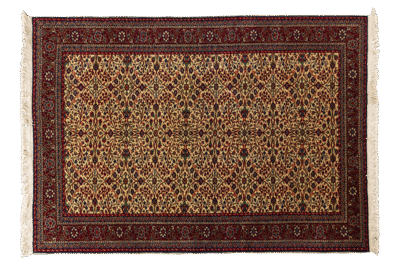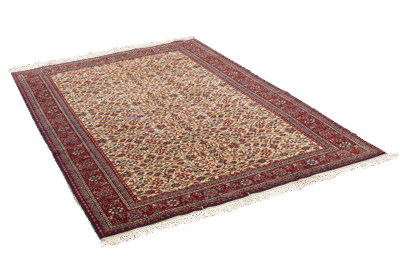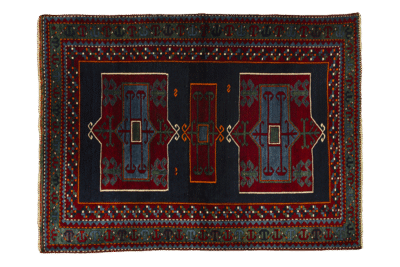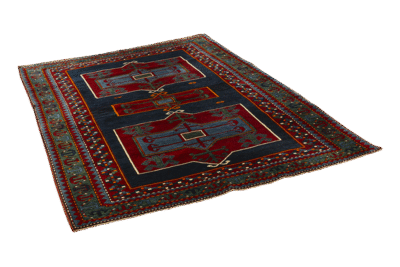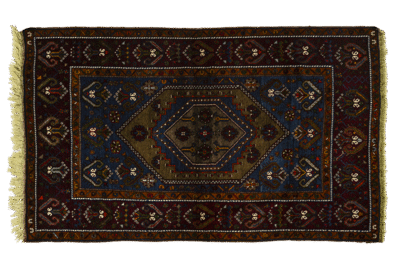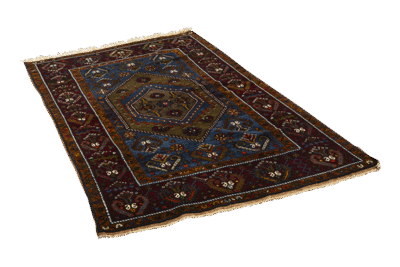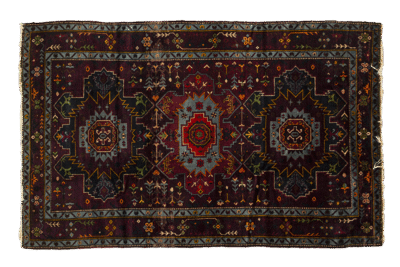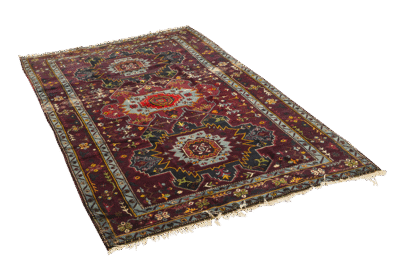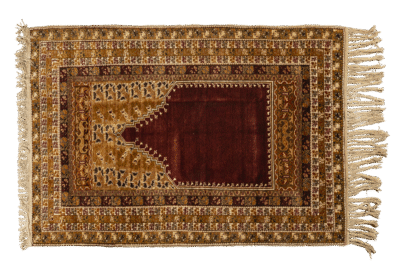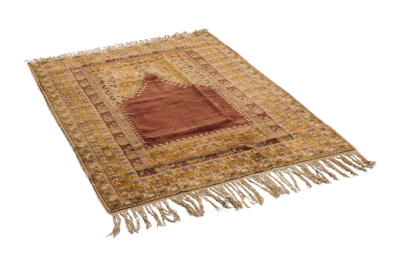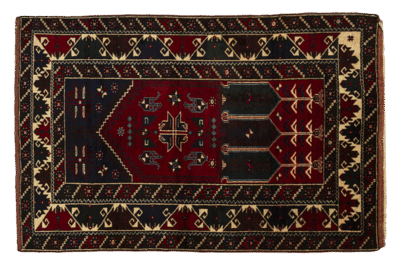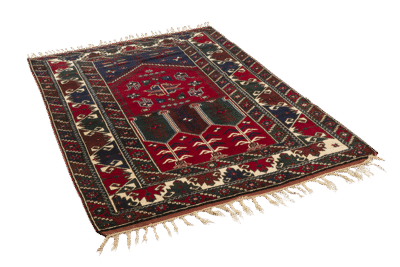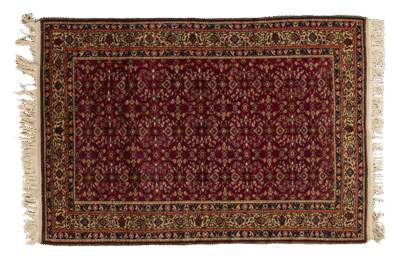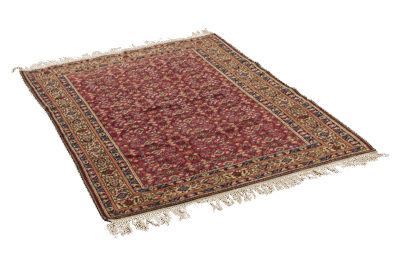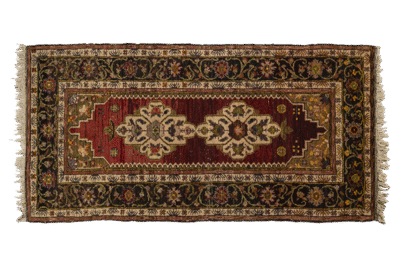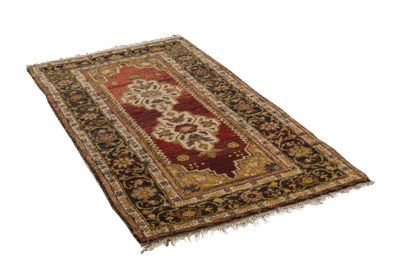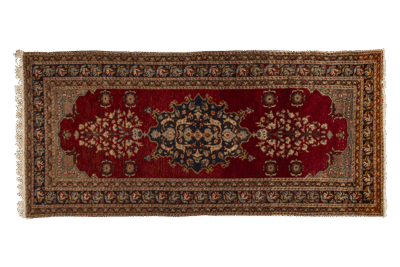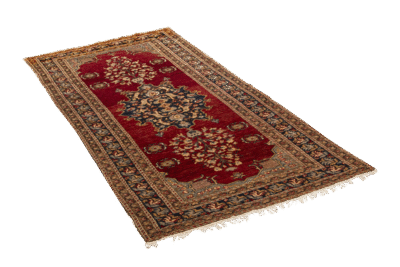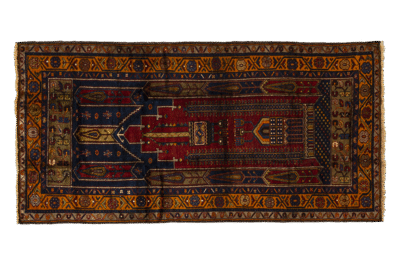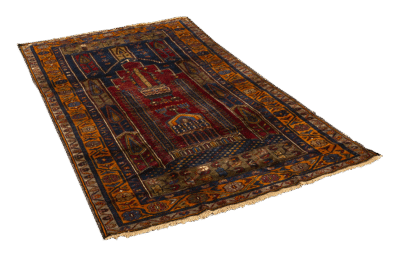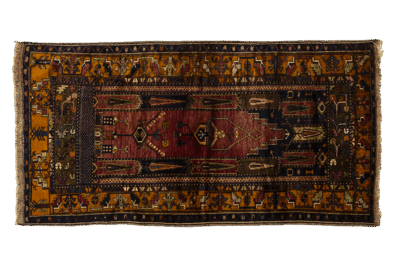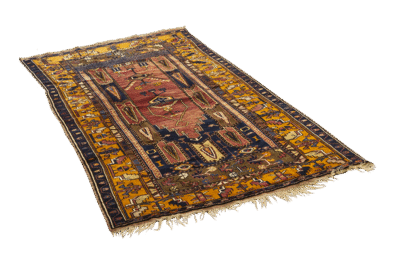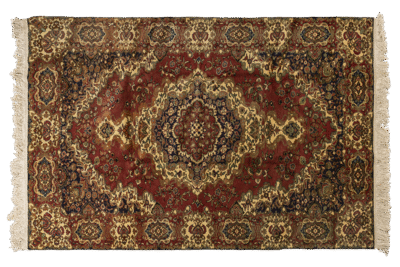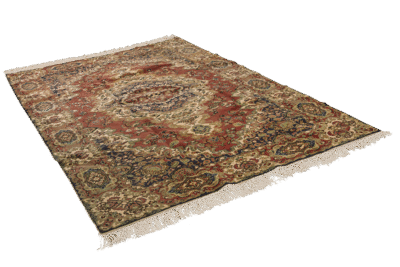Phoolraas
Woven in the mid-20th century, “Phoolraas” (Abundance of Flowers – Indian) features a delicately structured floral lattice set against a pale ivory-toned field. The design showcases a network of stylized blossoms, leaves, and slender vines. The vine-scroll arrangement conveys a sense of continuity and balance, while the densely rendered flowers woven in rich reds, greens, and blues evoke the beauty of nature and themes of abundance.
Woven with the traditional Ghiordes knot on a cotton foundation, Phoolraas features a tightly knotted wool pile, offering both softness and durability. Ideal for collectors, decorators, or those curating a personal textile collection, Phoolraas is especially suited for calm, bright interiors, bedrooms, libraries, or gallery-style wall display.
Qızıl Kölgə
This early-20th-century Azerbaijani rug, “Qızıl Kölgə” (Golden Shadow - Azerbaijani), features a rare interplay of symmetry, tribal symbolism, and rich contrast. Qızıl Kölgə showcases three vertically aligned medallions with stepped forms and branching motifs, all placed on a deep midnight blue field. These medallions are enclosed by multiple borders, including wide bands of zig-zag motifs, latch-hook elements, and checkerboard strips. Symbolically, the hooked motifs refer to protection, while the central medallions represent tribal unity and balance. The color palette, originating from plant-based dyes, includes dark indigo, rust red, light blue, olive green, and golden ochre.
Qızıl Kölgə's weaving utilizes the Turkish Ghiordes symmetrical knot, with a wool pile on a wool foundation and root-based natural dyes, allowing for structural durability and pattern clarity. Qızıl Kölgə is ideal for collectors, gallery installations, or design-forward interiors that celebrate powerful composition and regional heritage.
Ram’s Gate
This early-20th-century hall rug, “Ram’s Gate”, features a striking central hexagonal medallion in olive-brown and indigo tones, enclosed by a deep blue field populated with symbolic motifs. The layered medallion and stepped corner spandrels give the composition a strong architectural presence, while retaining a rustic charm. The borders are intricately filled with repeating ram’s horn symbols, representing power and fertility, and small hooked motifs interpreted as protective amulets. The palette includes deep indigo, earthy olive, burgundy red, and soft beige, derived from natural dyes, that have aged with a soft patina.
Ram’s Gate was hand-knotted using the Ghiordes (symmetrical) knot, using a wool pile on a wool foundation, providing lasting durability and crisp geometric definition. It is ideal for collectors and interior designers looking for a balanced composition with tribal character. Ram’s Gate’s proportions and visual rhythm will suit study rooms, entryways, or heritage-inspired interiors.
Rang-e Gisu
Woven in the late 19th century and originating from Azerbaijan, “Rang-e Gisu” (Color of Hair - Persian) features a bold geometric layout defined by a tripartite medallion scheme. The design is centered around a crimson rosette flanked by angular hexagonal medallions, anchoring the composition in symmetry and rhythm. Rang-e Gisu’s dark plum field is densely patterned with stylized botanical motifs and directional sprigs, such as the abstracted forms of cypress and blossoming flora, symbolizing rebirth and divine protection. Floral branches in olive green, saffron yellow, and powder blue animate the composition with asymmetry, while the serrated border features repeating hooked elements believed to function as protective amulets.
Rang-e Gisu is hand-knotted using the Ghiordes knot and plant-root based natural dyes, allowing for clean pattern resolution and rich color absorption. Rang-e Gisu is a confident statement rug, well-suited for grounding living spaces, anchoring a reading nook, or layering in a curated interior. Its graphic clarity, regional symbolism, and enduring palette make it a valuable and versatile addition to any collection.
Ravza
Hand-knotted in the early 20th Century, “Ravza” (Sacred Garden - Turkish/Arabic) features a clearly defined mihrab, expertly rendered in a burgundy field. Its stepped mihrab design, flanked by gold-toned spandrels and encased in richly decorated floral borders, speaks to both sacred function and aesthetic refinement. The wool pile absorbs the naturally dyed colors with clarity; deep reds and ochres dominate the composition, accented by muted greens, browns, and ivory. Multiple guard borders with repeating rosette and vine motifs offer a balanced frame to the field, emphasizing the spiritual purpose of the design. Symbolically, the mihrab represents divine direction, while the recurring blossoms evoke paradise and spiritual renewal. Though the geometric motifs, the focus remains on the sacred space defined by the niche.
Crafted using the traditional Turkish Ghiordes knot, Ravza’s high-quality wool pile on a cotton foundation delivers clarity in pattern and durability in use. Ravza is ideal for designers curating devotional interiors, or anyone seeking a meaningful Anatolian weaving with spiritual depth and structural elegance.
Red Sentinel
Hand-knotted in the late-20th-century, “Red Sentinel” (Burnt Earth - French) features a central field with prayer niche (mihrab) composition, stylized with bold architectural outlines and flanked by abstracted zoomorphic and geometric motifs, representing amulets, animals, and protection symbols. A series of spaced ram's horn forms and hooked border elements reinforce its symbolic richness. Red Sentinel’s rich red and midnight blue color palette is accented by dark green and ivory, creating sharp contrast and graphic clarity. The border frames the composition with triangle-based motifs, leaf and vine forms.
Hand-knotted using durable Turkish (Ghiordes) knots, Red Sentinel is made entirely from hand-spun wool on a wool foundation, and plant-based dyes, lending it a robust texture and rustic authenticity. Perfect for those drawn to bold tribal artistry and meaningful tradition, Red Sentinel is a standout piece. Its architectural prayer-niche design and earthy tones make it ideal for entryways, quiet study corners, or even as a striking wall display, adding depth, culture, and character to any space.
Rodochorio
Hand-knotted in the mid-20th Century, “Rodochorio” (Village of Roses - Greek) features an all-over design of stylized floral bouquets interspersed with geometric forms across a rich ruby-red field. The multiple borders showcase a flowing vine scroll enriched with blossoms and geometric flourishes, offering a strong frame that enhances the interior rhythm of the piece. The floral motifs of Rodochorio evoke growth, fertility, and abundance, while diamond and rosette forms allude to femininity, continuity, and life energy.
Crafted using the traditional Turkish Ghiordes knotting technique, Rodochorio’s high-quality wool pile delivers clarity in pattern and durability in use. Absorbent dyes render vivid contrasts in deep red, ivory, navy blue, and soft green. Rodochorio is ideal for those seeking a timeless, versatile statement piece with historical depth and decorative richness.
Rose of the East
Hand-knotted in the early-20th-century, “Rose of the East” reveals a time of transition from geometric tribal compositions to more floral-inspired urban design. The piece features two symmetrically elongated medallions, set against a terracotta-red field with a rosette structure at its core. The floral forms are anchored in linear symmetry, reflecting local symbolism and aesthetic balance. Rose of the East is framed by multiple borders; the innermost features small floral repeats, while the outermost is dominated by dark blossoming palmettes and vines, rendered in deep indigo, cream, and pistachio green. The floral medallions are associated with fertility, growth, and continuity, while the botanical border elements symbolize prosperity and the cyclic nature of life.
Rose of the East is knotted using the Ghiordes style with a wool pile on a cotton foundation with medium-fine knot density. Ideal for vintage lovers, collectors, or interior designers seeking a soft yet formal presence, Rose of the East works beautifully in reading rooms, hallways, or layered in transitional spaces.
Roshan
“Roshan” (radiant/illuminated - Persian), a hall rug woven in the late-20th-century, presents a refined and symmetrical composition ideal for corridor or entryway spaces. Roshan features a central floral medallion elongated along the vertical axis, flanked by floral sprays and framed by patterned borders. The deep red field creates a dramatic backdrop, while complementary dark blue shades, soft beige, and muted green form the botanical motifs throughout the piece. The floral motifs refer to fertility, abundance, and renewal, and the repeating patterns along the borders emphasize the notions of continuity and balance. Woven using the Ghiordes knot,
Roshan was woven with a wool pile on a cotton foundation for durability and clarity of floral detailing. Ideal for rug collectors or designers looking to introduce symmetry, elegance, and tradition into transitional spaces.
Ruhaniyah
A prayer rug, “Ruhaniyah” (Spirituality - Arabic) from the mid-20th-century, exemplifies bold geometry and spiritual symbolism. Hand-knotted using the traditional Turkish Ghiordes knot with a wool pile on a wool foundation, Ruhaniyah features a stepped mihrab, rendered in deep burgundy with spandrels in indigo. The field is framed by ochre borders punctuated with symbolic motifs in muted green, navy, and beige, showcasing a balanced color palette made from plant-based natural dyes. The stepped mihrab symbolizes a sacred gateway, while the surrounding ram’s horn motifs denote strength, fertility, and protection. Repeating hooked shapes act as talismanic guards against misfortune, and bird figures as soul-guides and incoming good news. These design choices reflect the dual function of Ruhaniyah: devotion and protection.
Ruhaniyah is ideal for collectors, or those curating a meaningful personal space, to be used as a wall display or for light functional use in meditation areas.
Saffron Gateway
Hand-knotted in the mid-20th-century, “Saffron Gateway” features a stepped mihrab, rendered in burgundy and navy-blue hues, contrasting with an ochre border, highlighted by touches of green, ivory, and black, forming an earthy palette. The multiple borders frame the central design with repeating ram's horn motifs, symbolizing protection and strength. Additional hooked forms, resembling amulets, serve a talismanic role, while bird-abstractions convey themes of freedom and divine messages.
Saffron Gateway is woven with the durable Ghiordes knot, using hand-spun wool on a wool base, and plant-based natural dyes. Saffron Gateway appeals to collectors, design professionals, and heritage lovers alike, those who appreciate authenticity and regional symbolism. Ideal for use in a reading room, entryway, or studio, it offers not only visual depth but also a story woven into its knots.
Sahra
“Sahra” (Desert - Arabic) features a traditional central medallion design and was woven in the mid-to-late 20th century by skilled artisans in a professional workshop setting. The design draws from a multi-lobed medallion, filled with floral abstractions framed by intricate corner spandrels and a richly decorated border. The deep red field creates visual depth, while accents in ivory, dark blue, and muted greens add structure and contrast across the composition. The balance between geometry and botanical curves reflects refined taste and technical mastery.
Made with a wool pile on a cotton foundation and knotted using the symmetrical Ghiordes technique, Sahra ensures both durability and clarity of design. The medium-to-high knot density indicates this rug was produced for a quality-conscious market, combining long-term use with sophisticated aesthetics. Ideal for collectors and those curating refined spaces, Sahra stands out as a centerpiece that complements both traditional and transitional interiors.

